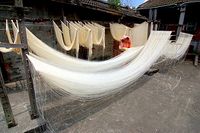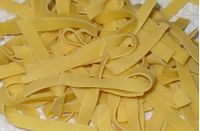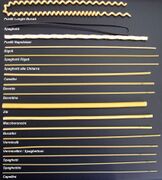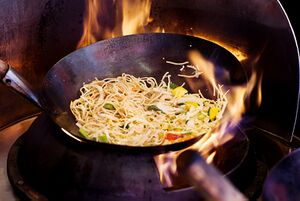شعيرية
 | |
| Place of origin | The earliest record of noodles was discovered in northwestern China, from 4000 years ago.[1] |
|---|---|
| Main ingredients | Unleavened dough |
| |
الشعيرية Noodle ، هي نوع من الطعام يتكون من نوع من العجائن المسلوق في الماء المغلى، كلمة نودل مشتقة من كلمة Nudel الألمانية التي تعنى المكرونة, من الممكن أن تكون لها صلة بالكلمة اللاتينية Nodus أى العقدة, نودل هو مصطللح عام لك العجائن المسلوقة في الماء المغلى والتي تكون على شكل الشعرية، ولا تؤثر مكونات العجينة على التسمية مطلقا
التاريخ
أول من ابتكر النودل هي أسرة هان الشرقية بين 25 و 225 ميلادية. في أكتوبر عام 2005، أكتشفت أقدم نودل على وجه الأرض وعثر عليها في منطقة لاجيا في تشينغهاي الصينية، تلك النودل التي ظهر انها مصنعة من ذيل الثعلب الدخن
أنواع الشعرية حسب المكون الأساسي
الدخن
القمح
- شوكا مين (中华麺) : اليابانية "الشعرية الصينية" :نوع يابانى من النودل وتسمى أيضا رامين، شانبون، ياكسوبا
- مى بوك (拉面:شعرية شهيرة في جنوب شرق آسيا
- باستا:بها 350 مكون من المطبخ الإيطالى
- سومينそうめん:نودل يابانية شديدة الدقة (رفيعة)
- سباتتزلى:نوع منم النودل مصنوع من القمح والبيض
الأرز

- هي فين أو هوفن河粉: نوع من النودل مصنوع من الأرز
فول مونج
- شعرية سيلوفان:تعرف أيضا باسم النودل الزجاجية(粉丝)
أطباق الشعيرية
- الشعرية الأساسية : هذه هي مطهية في الماء أو مرق، ثم ينضب. الأغذية الأخرى ويمكن إضافة (على سبيل المثال صلصة المعكرونة) أو الشعرية، إضافة إلى الأغذية الأخرى (انظر lasagna المقلية أو الشعرية)
- ثريد الشعرية: أطباق مصنوعة من اثارة الشعرية المقلية مع مختلف اللحوم والمأكولات البحرية أو الخضروات. ومن أمثلة ذلك تشاو mein، لو mein، goreng مي، مي hokkien، بعض أنواع pancit، ومنصة yakisoba التايلاندية.
- حساء المعكرونة: قدمت في حساء الشعرية. ومن الأمثلة phở، حساء لحم البقر، رامين، laksa، saimin وbatchoy، وحساء الدجاج والمعكرونة.
History
Origin
The earliest written record of noodles is found in a book dated to the Eastern Han period (25–220 CE).[1] Noodles made from wheat dough became a prominent food for the people of the Han dynasty.[2] The oldest evidence of noodles was from 4,000 years ago in China.[1] In 2005, a team of archaeologists reported finding an earthenware bowl that contained 4,000-year-old noodles at the Lajia archaeological site.[3] These noodles were said to resemble lamian, a type of Chinese noodle.[3] Analyzing the husk phytoliths and starch grains present in the sediment associated with the noodles, they were identified as millet belonging to Panicum miliaceum and Setaria italica.[3] However, other researchers cast doubt that Lajia's noodles were made from specifically millet: it is difficult to make pure millet noodles, it is unclear whether the analyzed residue were directly derived from Lajia's noodles themselves, starch morphology after cooking shows distinctive alterations that does not fit with Lajia's noodles, and it is uncertain whether the starch-like grains from Laijia's noodles are starch as they show some non-starch characteristics.[4]
Food historians generally estimate that pasta's origin is from among the Mediterranean countries:[5] a homogenous mixture of flour and water called itrion as described by 2nd-century Greek physician Galen,[6] among 3rd to 5th-century Jews as itrium as described by the Jerusalem Talmud[6] and as itriyya (Arabic cognate of the Greek word), string-like shapes made of semolina and dried before cooking as defined by the 9th-century Aramean physician and lexicographer Isho bar Ali.[7]
Historical variations
East Asia
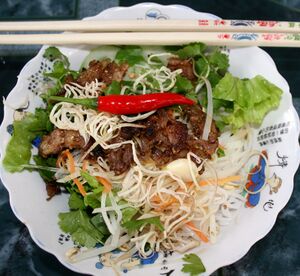
There are over 1,200 types of noodles commonly consumed in China today.[8] Due to the vast diversity of Chinese noodles available, there is no unifying Chinese word for the Western concept of "noodles". In Mandarin, miàn (simplified Chinese: 面; traditional Chinese: 麵) refers to noodles made from wheat flour and grains such as millet, sorghum, and oats. While fěn (粉) refers to noodles made from other starches, particularly rice flour and mung bean starch.[9]
Wheat noodles in Japan (udon) were adapted from a Chinese recipe as early as the 9th century. Innovations continued, such as noodles made with buckwheat (naengmyeon) were developed in the Joseon Dynasty of Korea (1392–1897). Ramen noodles, based on southern Chinese noodle dishes from Guangzhou but named after the northern Chinese lamian, became common in Japan by 1900.[10][11][12][13]
Central Asia
Kesme or erişte noodles were eaten by Turkic peoples by the 13th century.
West Asia
Ash reshteh (noodles in thick soup with herbs) is one of the most popular dishes in some middle eastern countries such as Iran, which was brought through Turco-Mongol.
Europe
In the 1st century BCE, Horace wrote of fried sheets of dough called lagana.[6] However, the cooking method does not correspond to the current definition of either a fresh or dry pasta product.[6]
Italy
The first concrete information on pasta products in Italy dates back to the Etruscan civilization, the Testaroli. The first noodles will only appear much later, in the 10th or 11th centuries,[6] and there is a popular legend about Marco Polo bringing the first pasta back from China. Modern historians do not give much credibility to the story and rather believe the first noodles were imported earlier from the Arabs, in a form called rishta.[14] Pasta has taken on a variety of shapes, often based on regional specializations.
Germany
In Germany, documents dating from 1725 mention Spätzle. Medieval illustrations are believed to place this noodle at an even earlier date.[15]
Ancient Israel and diaspora
The Latinized word itrium referred to a kind of boiled dough.[6] Arabs adapted noodles for long journeys in the fifth century, the first written record of dry pasta. Muhammad al-Idrisi wrote in 1154 that itriyya was manufactured and exported from Norman Sicily. Itriya was also known by the Persian Jews during early Persian rule (when they spoke Aramaic) and during Islamic rule. It referred to a small soup noodle, of Greek origin, prepared by twisting bits of kneaded dough into shape, resembling Italian orzo.[16]
Polish Jews
Zacierki is a type of noodle found in Polish Jewish cuisine.[17] It was part of the rations distributed to Jewish victims in the Łódź Ghetto by the Nazis. (Out of the "major ghettos", Łódź was the most affected by hunger, starvation and malnutrition-related deaths.) The diary of a young Jewish girl from Łódź recounts a fight she had with her father over a spoonful of zacierki taken from the family's meager supply of 200 grams a week.[18][19]
الأنواع حسب المكون الرئيسي
القمح
الأرز
|
الحنطة السوداء
البيضEgg noodles are made of a mixture of egg and flour.
غيرهم
|
أنواع الأطباق

- Baked noodles: Boiled and drained noodles are combined with other ingredients and baked. Common examples include many casseroles.
- Basic noodles: These are cooked in water or broth, then drained. Other foods can be added or the noodles are added to other foods (see fried noodles) or the noodles can be served plain with a dipping sauce or oil to be added at the table. In general, noodles are soft and absorb flavors.
- Chilled noodles: noodles that are served cold, sometimes in a salad. Examples include Thai glass noodle salad and cold udon.
- Fried noodles: dishes made of noodles stir fried with various meats, seafood, vegetables, and dairy products. Examples include chow mein, lo mein, mie goreng, hokkien mee, some varieties of pancit, yakisoba, tallarín saltado, and pad thai.
- Noodle soup: noodles served in broth. Examples include phở, beef noodle soup, chicken noodle soup, ramen, laksa, mie ayam, saimin, and batchoy.
الحفظ
انظر أيضا
المصادر
- ^ أ ب ت Roach, John (12 October 2005). "4,000-Year-Old Noodles Found in China". National Geographic: 1–2. Archived from the original on 20 October 2005.
- ^ Sinclair & Sinclair 2010.
- ^ أ ب ت Lu, Houyuan; Yang, Xiaoyan; Ye, Maolin; et al. (13 October 2005). "Culinary archaeology: Millet noodles in Late Neolithic China". Nature. 437 (7061): 967–968. Bibcode:2005Natur.437..967L. doi:10.1038/437967a. PMID 16222289. S2CID 4385122.
- ^ Ge, W.; Liu, L.; Chen, X.; Jin, Z. (2011). "Can noodles be made from millet? An experimental investigation of noodle manufacture together with starch grain analyses". Archaeometry. 53: 194–204. doi:10.1111/j.1475-4754.2010.00539.x.
- ^ López, Alfonso (8 July 2016). "The Twisted History of Pasta". National Geographic. Archived from the original on 14 December 2019. Retrieved 13 December 2019.
- ^ أ ب ت ث ج ح Serventi & Sabban 2002.
- ^ "A medical text in Arabic written by a Jewish doctor living in Tunisia in the early 900s" (Dickie 2008: 21).
- ^ "Noodles in Contemporary China: Social Aspects underlying the Noodle Evolution (Qiulun Li) – Noodles on the Silk Road" (in الإنجليزية الأمريكية). Retrieved 2022-07-01.
- ^ RAICHLEN, STEVEN (January 30, 1992). "Noodle nomenclature". Atlanta Journal-Constitution, The (GA). pp. W/6.
- ^ "Japanese Noodles (No. 4)". Kikkoman Corporation (in اليابانية). Retrieved 2022-07-20.
- ^ "Part 1: China Origin". Ramen Culture (in الإنجليزية الأمريكية). Retrieved 2022-07-20.
- ^ Media, USEN. "Indespensable Knowledge For Every Ramen Lover! A Glossary with Shop Recommendations". SAVOR JAPAN (in الإنجليزية). Retrieved 2022-07-20.
- ^ "榨菜肉丝面的南北差异及制作方法". Sohu.
- ^ Toscana, Cucina (2017-07-12). "The International Origins of Pasta | Cucina Toscana Salt Lake City". Cucina Toscana (in الإنجليزية الأمريكية). Retrieved 2023-05-18.
- ^ "City Profile: Stuttgart". London: Embassy of Germany, London. Archived from the original (PDF) on 27 July 2017. Retrieved 26 November 2015.
Spätzle is a city specialty.
- ^ Rodinson, Perry & Arberry 2001.
- ^ Strybel, Robert; Strybel, Maria (2005). Polish Heritage Cookery. Hippocrene Books. ISBN 978-0-7818-1124-8.
- ^ Zapruder, Alexandra (2015). Salvaged Pages: Young Writers' Diaries of the Holocaust. Yale University Press. pp. 226–242. ISBN 978-0-300-20599-2.
- ^ Heberer, Patricia (2011-05-31). Children during the Holocaust. Rowman Altamira. ISBN 978-0-7591-1986-4.
- ^ Kitchen, Leanne (January 8, 2019). "Know your noodle: The ultimate guide to Asian noodles". SBS-TV. Retrieved 24 March 2020.
- ^ Klatskin, Debbie. "Lokshen Noodles". PBS. Retrieved 24 March 2020.
- ^ "Turkish Egg Noodle (Erişte)". Almost Turkish Recipes. Retrieved 24 March 2020.
- ^ Cloake, Felicity (February 20, 2019). "How to make perfect spätzle noodles". The Guardian. Retrieved 24 March 2020.
- CS1 الإنجليزية الأمريكية-language sources (en-us)
- CS1 اليابانية-language sources (ja)
- Short description is different from Wikidata
- Articles with hatnote templates targeting a nonexistent page
- مقالات تحتوي نصوصاً باللغة التبتية
- Pages with empty portal template
- Pages using columns-list with unknown parameters
- معجنات
- شعيرية
- أغذية أساسية
